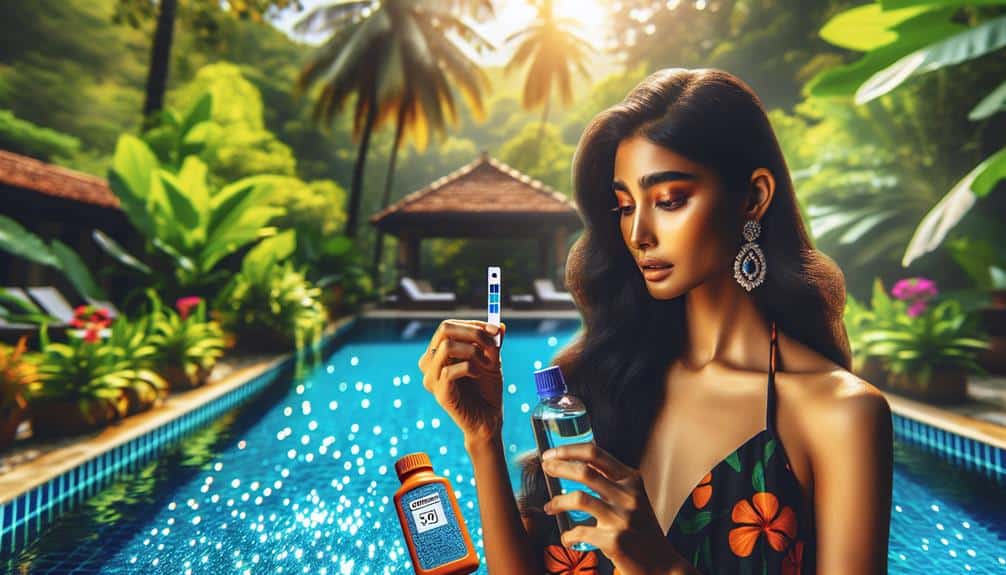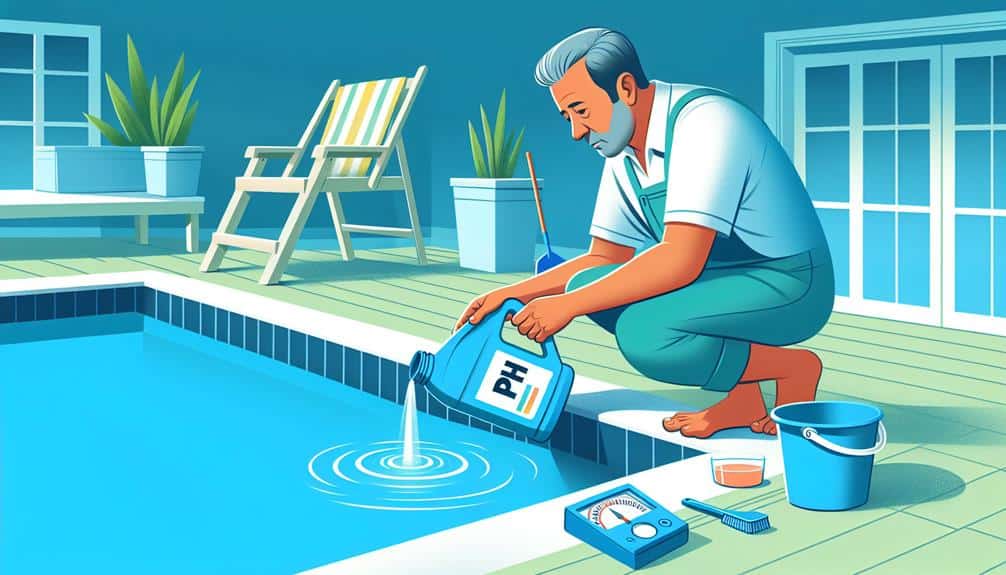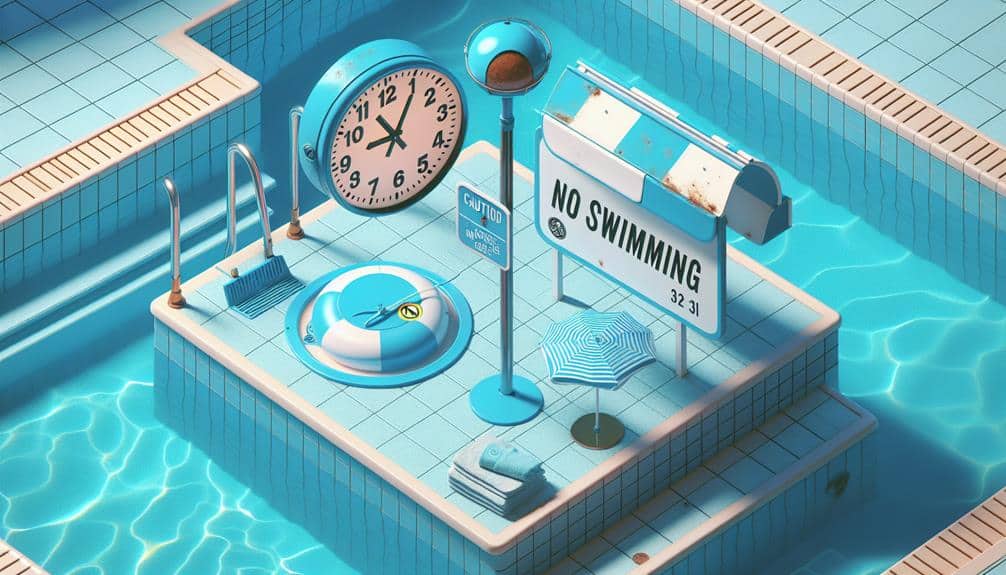If you’ve ever felt like your swimming pool is practically a giant chlorine reservoir, fret not; there are ways to bring those levels down effectively. By exploring alternative options like chlorine neutralizers and non-chlorine shock treatments, you can strike a balance that keeps your pool clean without overwhelming it with chemicals. But wait, there’s more to discover about maintaining a crystal-clear pool that’s gentle on your skin and eyes.
Importance of Balancing Chlorine Levels
To maintain a safe and clean swimming environment, balancing chlorine levels is crucial. While chlorine is commonly used to disinfect pools, there are chlorine alternatives that offer benefits such as reduced skin and eye irritation.
Natural pool solutions have gained popularity due to their effectiveness in keeping water clean without the strong chemical smell often associated with chlorine. These alternatives not only provide a more pleasant swimming experience but also minimize the risk of respiratory issues that can arise from chlorine exposure.
Test Chlorine Levels Regularly
Regularly testing the chlorine levels in your swimming pool is key to ensuring a safe and clean environment for swimmers. By monitoring the chlorine levels, you can maintain proper water quality and chemical balance. Testing methods vary, with options like test strips or liquid test kits readily available for purchase at pool supply stores. These tests provide accurate readings of the chlorine levels in your pool, helping you determine if adjustments are needed.
In addition to traditional chlorine, there are chlorine alternatives like bromine or mineral-based systems that can be used in pools. These alternatives offer different benefits and may require specific testing methods to ensure their effectiveness in maintaining water quality.
Consistent testing allows you to stay proactive in managing your pool’s chlorine levels, preventing issues such as eye irritation or the growth of harmful bacteria. By staying on top of your testing routine, you can enjoy a well-balanced pool environment that’s both safe and enjoyable for all swimmers.
Use Chlorine Neutralizers
Consider utilizing chlorine neutralizers to balance and maintain the chlorine levels in your swimming pool effectively. Chlorine alternatives can provide numerous benefits, such as reducing skin and eye irritation commonly associated with traditional chlorine treatments. Neutralizing agents play a crucial role in ensuring the effectiveness of your pool’s chlorine levels without causing harm to swimmers or the pool itself.
When selecting a chlorine neutralizer, opt for products that contain sodium thiosulfate or ascorbic acid. These substances work by chemically reacting with chlorine, rendering it harmless while still allowing it to effectively sanitize the water. By using chlorine neutralizers, you can enjoy a more balanced and comfortable swimming experience.
The effectiveness of chlorine neutralizers is evident in their ability to quickly reduce chlorine levels in your pool. This rapid action helps prevent over-chlorination and keeps the water safe for swimming. Additionally, neutralizers can aid in maintaining a stable chlorine residual, ensuring that your pool remains clean and clear throughout the swimming season.
Opt for Non-Chlorine Shock Treatments
When reducing chlorine in your swimming pool, opting for non-chlorine shock treatments can offer various benefits.
You should consider the application and dosage of these treatments to ensure their effectiveness.
Non-chlorine shocks can provide you with results that are both efficient and sustainable for maintaining a clean pool environment.
Non-Chlorine Shock Benefits
To enhance water quality and reduce chlorine levels in your swimming pool, consider the benefits of non-chlorine shock treatments.
Non-chlorine shock treatments offer several advantages over traditional chlorine-based shock treatments. One of the key benefits is their effectiveness in oxidizing organic contaminants and eliminating bacteria without raising chlorine levels excessively. This makes them a safer alternative for swimmers and reduces the risk of skin and eye irritation.
Additionally, non-chlorine shock treatments are gentler on pool surfaces and equipment, prolonging their lifespan. By choosing non-chlorine shock treatments, you can maintain a clean and healthy pool environment while minimizing the use of chlorine.
Make the switch today to experience these benefits firsthand.
Application and Dosage
For optimal results, incorporate non-chlorine shock treatments into your swimming pool maintenance routine to address Application and Dosage effectively. When using chemical alternatives, follow the proper usage instructions provided by the manufacturer. Typically, non-chlorine shock treatments come in granular form, making them easy to apply. Ensure you wear appropriate safety gear like gloves and goggles when handling these products.
To determine the correct dosage, refer to the packaging or consult with a pool professional. It’s crucial to measure accurately to avoid over or under-treating your pool. Remember to store these chemicals in a cool, dry place away from direct sunlight and moisture.
Effectiveness and Results
Consider incorporating non-chlorine shock treatments into your pool maintenance routine for more effective results in reducing chlorine levels. Chlorine alternatives like potassium peroxymonosulfate or MPS are highly effective at breaking down chloramines and reducing chlorine levels in the pool.
When using non-chlorine shock treatments, you can expect quick and efficient chlorine reduction, providing a more comfortable swimming environment for you and your guests. These chlorine reduction techniques yield noticeable results within a short period, ensuring that your pool water remains balanced and safe for use.
Consider UV or Ozone Systems
Exploring UV or ozone systems can effectively reduce chlorine levels in your swimming pool while maintaining water quality. These systems offer alternative sanitizers and filtration methods that can help in keeping your pool clean and safe for swimming. Here are some key points to consider:
- UV Disinfection: UV systems use ultraviolet light to kill bacteria, viruses, and algae in the water without the need for additional chemicals, reducing the chlorine demand.
- Ozone Systems: Ozone generators produce ozone gas, which is a powerful oxidizer that can break down contaminants in the pool water, reducing the reliance on chlorine.
- Enhanced Filtration: UV and ozone systems can work in conjunction with your pool’s filtration system to remove impurities more effectively, leading to clearer and cleaner water.
Increase Pool Circulation
To improve your pool circulation, consider strategies such as:
- Enhancing water movement
- Utilizing pool skimmers effectively
- Incorporating water features
By ensuring proper circulation, you can:
- Distribute chemicals evenly
- Reduce stagnant areas
- Promote a healthier swimming environment for you and your guests.
Enhancing pool circulation is a proactive step toward maintaining water quality and minimizing the need for excessive chlorine.
Improve Water Circulation
Improving water circulation in your swimming pool can be achieved by adjusting the direction and speed of your pool’s jets. This is crucial for maintaining good water quality and ensuring that your filtration system works effectively. To increase pool circulation, consider the following:
- Adjust Jet Angles: Aim the jets towards the surface at a 45-degree angle to create surface turbulence, aiding in better water circulation.
- Increase Pump Speed: Running your pool pump at a higher speed can enhance water movement and distribution throughout the pool.
- Use Water Features: Utilize water features like fountains or waterfalls to introduce more agitation and movement, promoting better overall circulation.
Use Pool Skimmers
Consider utilizing pool skimmers as a practical method to enhance pool circulation and reduce chlorine levels effectively. Pool skimmers offer various benefits, including aiding in pool maintenance by trapping leaves, debris, and other contaminants before they sink and decompose, which can lead to increased chlorine demand.
By improving water circulation, skimmers help distribute chlorine more efficiently throughout the pool, reducing the overall amount needed to maintain water quality. Regularly emptying skimmer baskets further prevents organic matter from breaking down and consuming excess chlorine.
This proactive approach not only keeps your pool clean but also contributes to a healthier swimming environment while minimizing chlorine usage, making it a cost-effective and eco-friendly choice for your pool maintenance routine.
Add Water Features
Enhance your pool’s circulation by incorporating water features. Water features not only add a touch of elegance to your pool but also help in reducing chlorine levels by promoting better water circulation.
Consider the following options:
- Waterfall Installation: Installing a waterfall not only creates a beautiful focal point but also helps aerate the water, reducing the reliance on chlorine.
- Water Fountain Options: Fountains not only add a soothing ambiance to your pool area but also aid in breaking the water’s surface tension, allowing for better gas exchange and reducing the need for excess chlorine.
- Spa Jets: Adding spa jets can help in circulating the water more effectively, ensuring that chlorine is distributed evenly throughout the pool.
Implement Proper Pool Maintenance
To maintain optimal chlorine levels in your swimming pool, establish a consistent and thorough pool maintenance routine. Start by incorporating green alternatives into your maintenance plan. Consider using eco-friendly pool cleaning products and equipment to reduce the use of harsh chemicals. Additionally, regularly check and clean your pool filters to ensure they’re working efficiently and removing contaminants effectively.
Maintenance tips are crucial for keeping chlorine levels balanced. Test your pool water regularly using a quality testing kit to monitor chlorine levels and adjust as needed. Skim the pool surface daily to remove debris that can affect chlorine effectiveness. Brush the pool walls and floor weekly to prevent algae growth and improve circulation. Keep your pool covered when not in use to prevent debris from entering and reducing chlorine levels. Lastly, ensure proper water circulation by running your pool pump for the recommended amount of time each day.
Seek Professional Assistance if Needed
If you encounter challenges maintaining proper chlorine levels or addressing pool maintenance issues, seeking professional assistance can provide valuable expertise and support. When it comes to pool care, sometimes it’s best to rely on the knowledge of professionals who can offer solutions tailored to your specific situation.
- Professional Advice: Pool experts can provide targeted advice on how to reduce chlorine levels effectively while keeping your pool safe and clean.
- Chemical Alternatives: Professionals can suggest alternative chemicals or treatment methods to help you achieve the desired chlorine balance without compromising the pool’s water quality.
- Expert Guidance: With their experience, professionals can guide you on the most suitable treatment options for your pool, ensuring optimal results and a comfortable swimming environment.
Don’t hesitate to reach out to professionals if you feel overwhelmed or uncertain about handling chlorine reduction in your pool. Their expertise can make a significant difference in maintaining a healthy and enjoyable swimming environment.
Frequently Asked Questions
Can I Use Saltwater Instead of Chlorine in My Pool?
Yes, you can use saltwater instead of chlorine in your pool. Saltwater benefits include softer feeling water and less skin irritation. It’s one of the chlorine alternatives that many pool owners find effective for maintaining a clean pool.
How Can I Prevent Skin and Eye Irritation From Chlorine?
To prevent skin and eye irritation from chlorine, consider alternative treatments like UV or ozone systems. Home remedies such as using Vitamin C or aloe vera can also help soothe irritation. Protect yourself while enjoying the pool.
What Are the Risks of Chlorine Overdosing in a Pool?
When you overdose chlorine in a pool, your health risks include skin and eye irritation, respiratory problems, and even potential poisoning. Additionally, the environmental impact can harm aquatic life and ecosystems, affecting the balance of the pool.
Is It Possible to Completely Eliminate Chlorine From a Pool?
You can’t completely eliminate chlorine from a pool, but you can explore chlorine alternatives to reduce its use. Remember pool chemical safety and consult with professionals for the best options to maintain a clean pool.
Are There Any Natural Alternatives to Chlorine for Pool Maintenance?
Looking for eco-friendly pool options? You’ll love discovering DIY solutions that are gentle on the environment. Embrace natural alternatives for pool maintenance. Dive into a world where your pool can be both clean and green.
Conclusion
In conclusion, maintaining balanced chlorine levels in your swimming pool is crucial for a safe and enjoyable swimming experience. Regular testing, using neutralizers, and exploring alternative treatments like UV or ozone systems can help you manage chlorine levels while keeping your pool clean and clear.
Proper maintenance and circulation are essential to ensuring your pool remains in top condition.
Don’t let chlorine levels affect your pool time. For reliable pool service in San Diego, contact us to keep your pool in perfect shape.

As the premier provider of pool services in San Diego, CA, our team at Pool Service San Diego specializes in maintenance, repair, and installation. With years of expertise, we’re dedicated to delivering exceptional care and sustainable solutions for your pool’s beauty and health.



